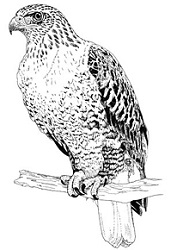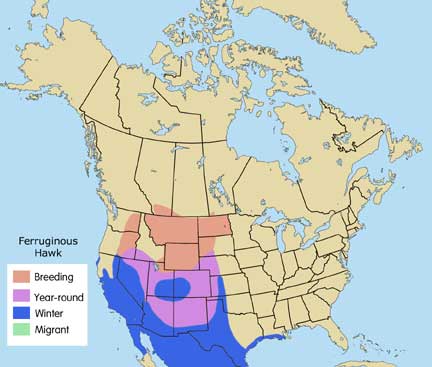
Scientific Name: Buteo regalis
As the ‘royal’ Latin name suggests, this is the largest and heaviest hawk in North America. The Ferruginous Hawk is about midway in size between other buteo hawks and the Golden Eagle, which it resembles in body shape, diet, flight, and nesting habits. Females are larger then males, but the genders have similar plumage. The head is big and heavy-billed; the chest is large; the wings are long, broad, and pointed; the legs are feathered down to the feet, which are relatively small, considering the large prey they routinely take. Adults have a rufous-red color on the back and shoulders, and red leggings that form a conspicuous V-shape against a whitish body and tail when viewed in flight overhead. The wings are gray-brown above, with large white crescent-shaped patches on the upper wing surface. Outer wing tips are dark on both upper and lower surfaces. The tail is a mixture of pale rust and white or gray, and unbanded. The head is pale, with gray cheeks, a dark cap. A dark morph, or variety, form less than 10% of the population, and vary in color from dark red to dark brown.
Male
Length: 20-26″
Wingspan: 48-56″
Weight: 2.4 lb. ave.
Female
Length: 22-27″
Wingspan: 53-60″
Weight: 3-4 lb.
State and federally protected.
Dry, open country including prairies, plains, badlands, high desert country. Best adapted to semiarid grasslands having scattered trees or rock outcrops, with taller trees along streams — habitat that can support an abundance of grassland rodents and rabbits.
90% of the diet consists of small mammals such as jackrabbits, prairie dogs, or ground squirrels, but also takes birds. Usually hunts by low, rapid flight over open ground, but will also hunt from a perch, soar high and swoop down on prey, or hover hunt.
Harsh alarm call of kreee-ah, or kaaah can be heard in breeding season. Also calls out a long, drawn-out keeeerrr typical of the buteo hawks, but with a lower, less harsh tone than a Red-tailed Hawk.
Builds huge nests of sticks, lined with turf or cow dung. Nests in trees, cliff faces, rock outcrops, or on the ground if no other site is available – and will strongly defend the nest against ground predators, even coyotes.
Collision with vehicles; electrocution and hitting power lines can be a problem, especially in the dry habitat these birds inhabit where trees are scarce and power poles can provide a good hunting perch. Poisonings are a major threat to these hawks, as well as to Golden Eagles and the endangered Black-footed Ferret, where ranchers have used rodenticides to kill prairie dogs or other ground-dwelling mammals whose burrows are deemed a hazard to livestock.

Breeding range is inland arid western states, from Canada to northern Arizona, New Mexico, and Texas; winter range extends south into Central Mexico.
Special Thanks for range maps:
Dan Gleason
BGleason Design & Illustration
Commercial & Scientific Illustration, Graphic Design
CraneDance Communications
Book Production/Design

